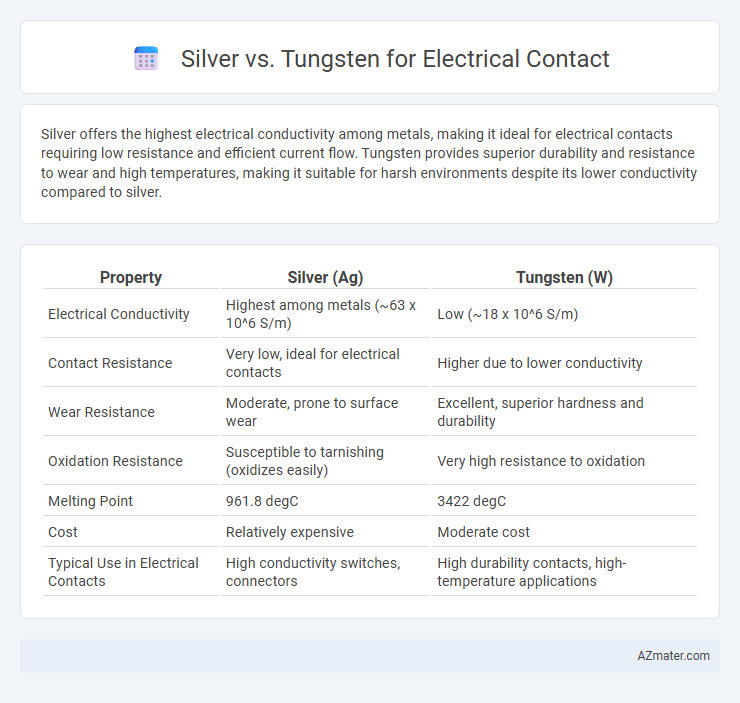Silver offers the highest electrical conductivity among metals, making it ideal for electrical contacts requiring low resistance and efficient current flow. Tungsten provides superior durability and resistance to wear and high temperatures, making it suitable for harsh environments despite its lower conductivity compared to silver.
Table of Comparison
| Property | Silver (Ag) | Tungsten (W) |
|---|---|---|
| Electrical Conductivity | Highest among metals (~63 x 10^6 S/m) | Low (~18 x 10^6 S/m) |
| Contact Resistance | Very low, ideal for electrical contacts | Higher due to lower conductivity |
| Wear Resistance | Moderate, prone to surface wear | Excellent, superior hardness and durability |
| Oxidation Resistance | Susceptible to tarnishing (oxidizes easily) | Very high resistance to oxidation |
| Melting Point | 961.8 degC | 3422 degC |
| Cost | Relatively expensive | Moderate cost |
| Typical Use in Electrical Contacts | High conductivity switches, connectors | High durability contacts, high-temperature applications |
Introduction to Electrical Contact Materials
Silver offers exceptional electrical conductivity and thermal properties, making it a preferred choice for low-resistance electrical contacts. Tungsten, known for its high melting point and mechanical strength, excels in high-temperature and arc-resistant contact applications. Both materials are essential in electrical contact design, balancing conductivity, durability, and wear resistance for optimal performance.
Key Properties of Silver and Tungsten
Silver exhibits excellent electrical conductivity at 65.8 x 10^6 S/m, making it ideal for minimizing contact resistance and power loss in electrical contacts. Tungsten offers superior mechanical strength with a melting point of 3422degC and hardness around 7.5 on the Mohs scale, enabling it to withstand harsh operating conditions and arcing. The combination of silver's conductivity and tungsten's durability often results in composite materials optimized for high-performance electrical contacts.
Conductivity Comparison: Silver vs Tungsten
Silver exhibits superior electrical conductivity at approximately 63 x 10^6 S/m, making it the most conductive metal, while tungsten has significantly lower conductivity around 18 x 10^6 S/m. This difference makes silver ideal for electrical contacts requiring minimal resistance and efficient current flow. However, tungsten's high melting point and durability are preferred in applications demanding contact wear resistance despite its lower conductivity.
Durability and Wear Resistance
Silver offers excellent electrical conductivity but has lower wear resistance compared to tungsten, which is known for its superior hardness and durability under electrical contact stress. Tungsten's high melting point and ability to withstand arcing make it ideal for applications requiring prolonged durability and minimal material degradation. Although tungsten contacts may have slightly higher electrical resistance than silver, their enhanced wear resistance significantly extends the lifespan of electrical components in demanding environments.
Performance in High-Temperature Environments
Tungsten excels in high-temperature environments due to its superior melting point of 3422degC, maintaining structural integrity and electrical conductivity where silver may degrade. Silver offers the best electrical conductivity at 63 x 10^6 S/m but softens significantly above 961degC, leading to potential performance loss under extreme heat. For reliable electrical contacts in high-temperature applications such as aerospace or industrial furnaces, tungsten is preferred for its durability and thermal stability despite silver's higher conductivity.
Oxidation and Corrosion Resistance
Silver exhibits excellent electrical conductivity but is prone to oxidation, which can increase contact resistance over time in electrical contacts. Tungsten offers superior corrosion resistance and maintains stable conductivity under harsh environmental conditions due to its high melting point and oxide layer stability. In applications where long-term reliability against oxidation and corrosion is critical, tungsten is preferred despite its lower electrical conductivity compared to silver.
Cost Analysis: Silver vs Tungsten
Silver offers superior electrical conductivity but comes at a higher cost, making it expensive for large-scale electrical contacts. Tungsten's lower price and excellent durability provide a cost-effective alternative despite its reduced conductivity compared to silver. In applications prioritizing budget and wear resistance, tungsten often delivers better overall value than silver for electrical contacts.
Applications in Electrical Engineering
Silver offers superior electrical conductivity and thermal performance, making it ideal for high-current electrical contacts in switches, relays, and circuit breakers. Tungsten provides exceptional hardness and resistance to arc erosion, frequently used in harsh environments such as high-voltage contacts and vacuum interrupters. Combining silver's conductivity with tungsten's durability enables advanced electrical engineering applications requiring both performance and longevity.
Environmental and Safety Considerations
Silver offers excellent electrical conductivity and natural corrosion resistance, reducing environmental impact by minimizing energy loss and maintenance needs. Tungsten, though less conductive, boasts higher melting points and wear resistance, enhancing safety in high-temperature or high-current applications by reducing risk of contact degradation or failure. Both metals require careful handling due to silver's potential toxicity in dust form and tungsten's brittleness, demanding appropriate safety protocols during manufacturing and disposal to mitigate environmental hazards.
Conclusion: Choosing the Right Material
Silver offers superior electrical conductivity and excellent thermal performance, making it ideal for low-voltage, high-current applications requiring minimal resistance. Tungsten provides exceptional durability and high melting points, suitable for environments with extreme wear, high temperatures, or arcing conditions. Selecting the right material depends on balancing conductivity needs against mechanical strength and thermal endurance specific to the electrical contact's operating environment.

Infographic: Silver vs Tungsten for Electrical Contact
 azmater.com
azmater.com